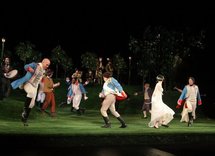
Actors perform in the 2009 Shakespeare in the Park opening night performance of 'Twelfth Night'
As a result of Hammond's research, the play will now be published alongside works like "Hamlet" and "King Lear" in the prestigious Arden Shakespeare series, while the Royal Shakespeare Company is said to be working on a reconstruction of the play.
"Cardenio" was written by Shakespeare and John Fletcher, a regular collaborator. It was performed twice in 1613, three years before Shakespeare's death.
Publisher Lewis Theobald later claimed he had three copies of the original play -- subsequently lost -- and released his adaptation of it in 1728.
But the play -- whose full title is "Double Falsehood; or, The Distrest Lovers" -- was dismissed by critics at the time, who said it was not a genuine work by Shakespeare.
"It's impossible to compare 'Double Falsehood' with 'Cardenio' because those manuscripts have been lost," Hammond said, quoted by The Daily Telegraph newspaper.
"But if you look inside the text there is the presence of three hands at work: Shakespeare, his collaborator John Fletcher and Theobald."
The professor has spent 10 years researching the play.
The play revolves around two beautiful women, Violante and Leonora, and two men: Henriquez, an aristocratic villain; and his lower-born rival Julio.
Henriquez perpetrates the "double falsehood" by nearly raping Violante and then courting Leonora, the betrothed of Julio. But the play ends with a reconciliation.
Jonathan Bate, a professor of Shakespeare and Renaissance Literature at Warwick University, said Hammond's research "proves that it is in some part Shakespearian".
"Theobald always knew the play was not Shakespeare's original, but a rewriting to conform to the conventions of Restoration theatre. This was common practice," he wrote in The Daily Telegraph.
"'Double Falsehood' is only an indirect version of Shakespeare's lost 'Cardenio'."
Stanley Wells, general editor of the Oxford Shakespeare series said: "There's more reason to believe that the play preserves bits of Fletcher than Shakespeare.
"However, there might be a bit of Shakespearean DNA in it," he was quoted as saying in The Daily Telegraph.
-----------------------------------------------------------------------
"Cardenio" was written by Shakespeare and John Fletcher, a regular collaborator. It was performed twice in 1613, three years before Shakespeare's death.
Publisher Lewis Theobald later claimed he had three copies of the original play -- subsequently lost -- and released his adaptation of it in 1728.
But the play -- whose full title is "Double Falsehood; or, The Distrest Lovers" -- was dismissed by critics at the time, who said it was not a genuine work by Shakespeare.
"It's impossible to compare 'Double Falsehood' with 'Cardenio' because those manuscripts have been lost," Hammond said, quoted by The Daily Telegraph newspaper.
"But if you look inside the text there is the presence of three hands at work: Shakespeare, his collaborator John Fletcher and Theobald."
The professor has spent 10 years researching the play.
The play revolves around two beautiful women, Violante and Leonora, and two men: Henriquez, an aristocratic villain; and his lower-born rival Julio.
Henriquez perpetrates the "double falsehood" by nearly raping Violante and then courting Leonora, the betrothed of Julio. But the play ends with a reconciliation.
Jonathan Bate, a professor of Shakespeare and Renaissance Literature at Warwick University, said Hammond's research "proves that it is in some part Shakespearian".
"Theobald always knew the play was not Shakespeare's original, but a rewriting to conform to the conventions of Restoration theatre. This was common practice," he wrote in The Daily Telegraph.
"'Double Falsehood' is only an indirect version of Shakespeare's lost 'Cardenio'."
Stanley Wells, general editor of the Oxford Shakespeare series said: "There's more reason to believe that the play preserves bits of Fletcher than Shakespeare.
"However, there might be a bit of Shakespearean DNA in it," he was quoted as saying in The Daily Telegraph.
-----------------------------------------------------------------------









 Home
Home Politics
Politics









